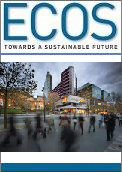
|
Published: 31 October 2011
Supporting best practice in soil carbon
To strengthen the science around the measurement of soil carbon – and help better inform farmers of the emissions abatement options available to them – the Australian Government is significantly expanding Carbon Farming Futures as part of the Clean Energy Future plan.
Agriculture remains an important component of the Australian economy, not to mention the lifeblood of regional Australia. Yet, few sectors will be affected as much as agriculture by changes in global climate.
Unless we do something, Australian agriculture as we know it will be harmed by adverse changes in temperature and rainfall. But, we also face the menace of extreme weather events like droughts, bushfires, floods and cyclones – all set to increase in their frequency under modelled global warming scenarios.
Landholders have an interest in addressing Australian carbon emissions, and it is perhaps understandable that Australian farmers have already begun to act on climate change.
Over the past few decades, landholders have moved to address large losses in soil organic carbon that have occurred since European colonisation. New forms of sustainable agriculture have evolved that retain nutrients while reducing soil disturbance, erosion and loss of soil carbon.
Methods such as generating carbon-heavy biochar from crop residues and adding it to weathered Australian soils are increasing the amount of stored carbon. These methods can also improve soil fertility. Increasing soil carbon has a proven flowthrough to improved soil structure and productivity, increased filtration and organic activity in the soil, and reduced runoff and erosion.
However, variations in climate – leading to events like soil warming and general drought – can undo such carbon abatement work and greatly increase carbon emissions from the land, highlighting the challenge of carbon sequestration in agriculture.
There are many possible and practical options for land-based carbon emissions reductions activities. To date, however, few methods have been proven to provide good carbon sequestration in the long run.
This issue of long-term carbon abatement (‘permanence’), combined with concerns arising from ‘additionality’ (i.e. uptake of processes that go beyond or add to business-as-usual agricultural processes that cut carbon), threaten to add to general uncertainty around what could be practical solutions.
It’s therefore not surprising that I’m often approached by landholders asking how to best reduce their carbon emissions. A lack of concrete knowledge in the rural community means that a number of simple emissions abatement options, which are easy to take up, are either unknown or under-explored.
The straightforward way to address soil carbon measurement issues is to bed down the science, and then get practical messages out to landholders. This will help ensure that farmers employ best-practice methods when it comes to soil carbon.
Under the $1.7 billion land sector component of Clean Energy Future plan, the government intends to do just this – by expanding Carbon Farming Futures to a fully fledged $429 million program.
Under this program, $201 million is set to target cutting-edge soil carbon science and management practice. The funding will be used to look at the viability of recent approaches to carbon abatement, and examine the best way to roll out skills and information to the wider farming community.
Also on the radar are new forms of carbon land management, such as the use of biochar in weathered soils, wide-scale sowing of new carbon-friendly crop and pasture species, and biofuel production.
Without focused research in areas like these, Australia risks missing out on low-cost sequestration opportunities as the world moves to tackle climate change.
Once the soil research is settled, the next step is to turn the science into on-the-ground practice. To properly tackle carbon loss, Australian farmers need to have viable soil carbon tools ready to go. Even when landholders have usable options, they also need certainty to confidently put process into practice. Without this confidence, landholders will miss out on a chance to diversify their land-based income by earning commercial carbon credits under the new Carbon Farming Initiative and Clean Energy legislation.
To help fix this problem, the program will provide assistance in turning viable abatement science into on-the-ground programs, with $20 million available for grants to support the conversion.
The Carbon Farming Initiative also includes a ‘positive list’, which will allow landholders to easily assess their soil carbon activities against a list of activity options that have been formally recognised as offering additional emissions abatement.
Concerns around permanence are also set to be addressed, with a legislative commitment by the Government to balance the need to maintain carbon stores for 100 years with the flexibility to terminate sequestration projects at any time – simply by handing back earned credits.
Funding will target the development of easy-to-use measurement techniques for farmers. These include abatement methods able to interface with new precision farming machinery, and on-farm sampling and lab analysis. Direct financial assistance and community outreach will assist landholders to take up this new on-farm technology.
With the $99 million Action on the ground program, the Government will seek to fund pilot programs that showcase the practicality of increasing carbon storage in agricultural soil.
As in North America and Europe, no-till farming methods that reduce soil disturbance are now well recognised in Australia for their ability to sequester carbon and improve soil quality through increases in surface soil carbon content.
As a case in point, Conservation Farmers in South Australia are demonstrating how using biochar can increase nutrient availability and improve the health of sandy soils. In western New South Wales, graziers are finding benefits in old farming techniques such as inter-row planning of crops with perennial pasture species. Deep rooting perennial species are showing good potential for sequestration, and this approach has the benefit of allowing cash cropping to continue.
As long as farmers are willing to take part in soil carbon innovation, the Government will support uptake of low-till farming, with a new tax rebate to support the purchase of conservation tillage equipment. Between 1 July 2012 and 30 June 2015, farmers purchasing minimum-till tine machines, disc openers and disc/tine and disc/blade hybrid equipment can claim a 15 per cent tax offset.
By requiring fewer tractor passes than traditional tills, new tine-type machinery can also help farmers reduce their fuel usage – cutting costs and carbon emissions.
To help build awareness of what’s on offer, a new team of farm extension officers will be put out into the community. Based on the cooperative approach that worked so well with the FarmReady program, the new officers will support landholders gain new skills and integrate good soil carbon practices into their properties.
Overall, the Carbon Farming Futures package is a comprehensive, evidence-based program. It’s the right step forward, which recognises that landholders – as well as soil scientists and experts – can play a vital part in reducing our carbon pollution.
By getting the right knowledge out to our rural areas, we can help farmers build environmental sustainability and climate change resilience, as well as improve productivity and help boost farming incomes.
Mark Dreyfus QC MP is the Federal Government’s Parliamentary Secretary for Climate Change and Energy Efficiency.






